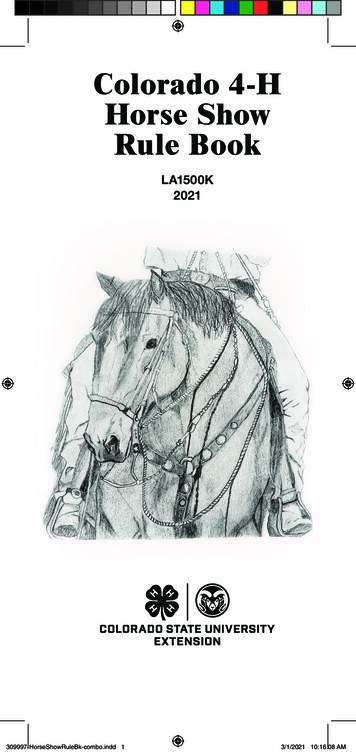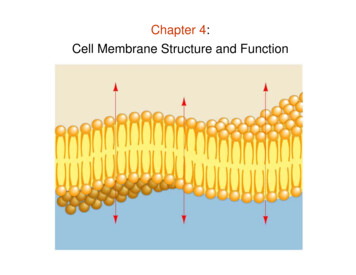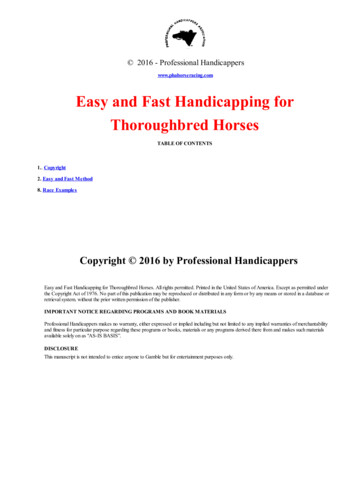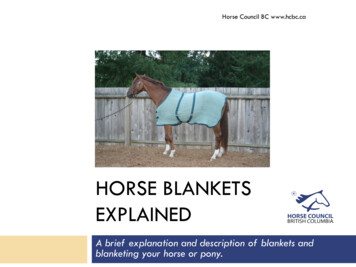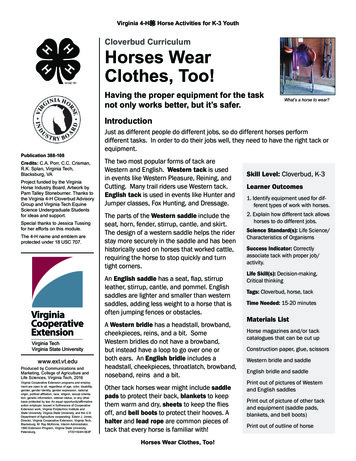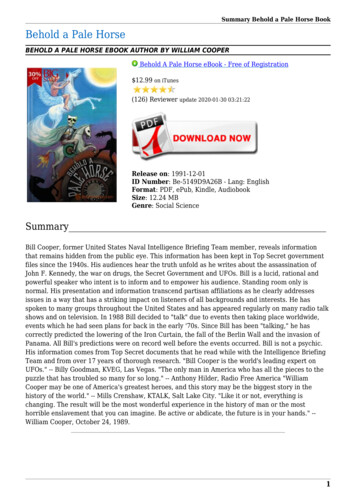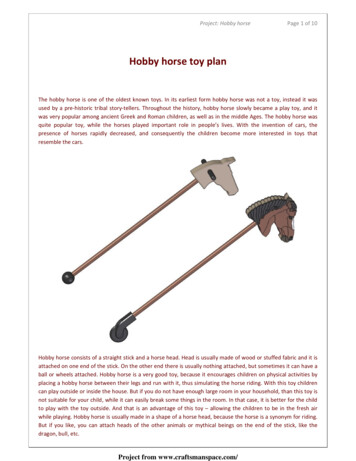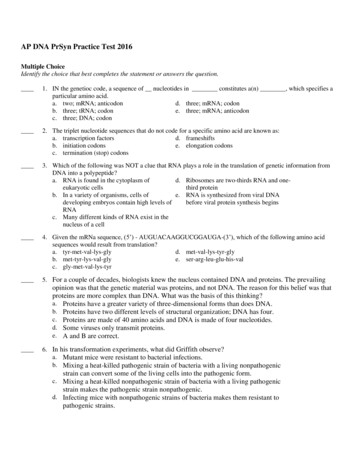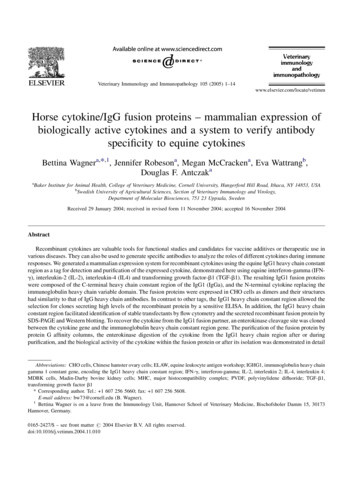
Transcription
Veterinary Immunology and Immunopathology 105 (2005) 1–14www.elsevier.com/locate/vetimmHorse cytokine/IgG fusion proteins – mammalian expression ofbiologically active cytokines and a system to verify antibodyspecificity to equine cytokinesBettina Wagnera,*,1, Jennifer Robesona, Megan McCrackena, Eva Wattrangb,Douglas F. AntczakaaBaker Institute for Animal Health, College of Veterinary Medicine, Cornell University, Hungerford Hill Road, Ithaca, NY 14853, USAbSwedish University of Agricultural Sciences, Section of Veterinary Immunology and Virology,Department of Molecular Biosciences, 751 23 Uppsala, SwedenReceived 29 January 2004; received in revised form 11 November 2004; accepted 16 November 2004AbstractRecombinant cytokines are valuable tools for functional studies and candidates for vaccine additives or therapeutic use invarious diseases. They can also be used to generate specific antibodies to analyze the roles of different cytokines during immuneresponses. We generated a mammalian expression system for recombinant cytokines using the equine IgG1 heavy chain constantregion as a tag for detection and purification of the expressed cytokine, demonstrated here using equine interferon-gamma (IFNg), interleukin-2 (IL-2), interleukin-4 (IL4) and transforming growth factor-b1 (TGF-b1). The resulting IgG1 fusion proteinswere composed of the C-terminal heavy chain constant region of the IgG1 (IgGa), and the N-terminal cytokine replacing theimmunoglobulin heavy chain variable domain. The fusion proteins were expressed in CHO cells as dimers and their structureshad similarity to that of IgG heavy chain antibodies. In contrast to other tags, the IgG1 heavy chain constant region allowed theselection for clones secreting high levels of the recombinant protein by a sensitive ELISA. In addition, the IgG1 heavy chainconstant region facilitated identification of stable transfectants by flow cytometry and the secreted recombinant fusion protein bySDS-PAGE and Western blotting. To recover the cytokine from the IgG1 fusion partner, an enterokinase cleavage site was clonedbetween the cytokine gene and the immunoglobulin heavy chain constant region gene. The purification of the fusion protein byprotein G affinity columns, the enterokinase digestion of the cytokine from the IgG1 heavy chain region after or duringpurification, and the biological activity of the cytokine within the fusion protein or after its isolation was demonstrated in detailAbbreviations: CHO cells, Chinese hamster ovary cells; ELAW, equine leukocyte antigen workshop; IGHG1, immunoglobulin heavy chaingamma 1 constant gene, encoding the IgG1 heavy chain constant region; IFN-g, interferon-gamma; IL-2, interleukin 2; IL-4, interleukin 4;MDBK cells, Madin-Darby bovine kidney cells; MHC, major histocompatibility complex; PVDF, polyvinylidene difluoride; TGF-b1,transforming growth factor b1* Corresponding author. Tel.: 1 607 256 5660; fax: 1 607 256 5608.E-mail address: bw73@cornell.edu (B. Wagner).1Bettina Wagner is on a leave from the Immunology Unit, Hannover School of Veterinary Medicine, Bischofsholer Damm 15, 30173Hannover, Germany.0165-2427/ – see front matter # 2004 Elsevier B.V. All rights reserved.doi:10.1016/j.vetimm.2004.11.010
2B. Wagner et al. / Veterinary Immunology and Immunopathology 105 (2005) 1–14for equine IFN-g/IgG1 by up-regulation of major histocompatibility complex (MHC) class II expression on horse lymphocytes.Biological activity could also be confirmed for the IL-2 and IL-4/IgG1 fusion proteins. To test the crossreactivity and specificityof anti-human TGF-b1, and anti-bovine and anti-canine IFN-g antibodies to respective horse cytokines, the four cytokine/IgG1fusion proteins were successfully used in ELISA, flow cytometry and/or Western blotting. In summary, equine IgG1 fusionproteins provide a source of recombinant proteins with high structural and functional homology to their native counterparts,including a convenient system for selection of stable, high expressing transfectants, and a means for monitoring specificity ofantibodies to equine cytokines.# 2004 Elsevier B.V. All rights reserved.Keywords: IgG; Fusion protein; Mammalian expression; Recombinant cytokine; Anti-cytokine antibodies; MHC class II; Horse1. IntroductionDuring the past decade recombinant equinecytokines have been generated using expressionsystems employing bacteria (Vandergrifft and Horohov, 1993; Steinbach et al., 2002; Hines et al., 2003),baculoviruses (McMonagle et al., 2001; Wu et al.,2002), and mammalian cells (Vandergrifft andHorohov, 1993; Dohmann et al., 2000; McMonagleet al., 2001; Cunningham et al., 2003). In general,bacterial expression results in high expression levelsof the recombinant protein, but it can also result in lossof biological activity, due to differences in proteinfolding and the lack of glycosylation in bacterial cells.In contrast, mammalian expression provides recombinant proteins with a high similarity to native proteinswith regard to their structure and biological functions.Compared with other expression systems, the disadvantage of the mammalian system is the considerably lower amount of recombinant protein produced(Wagner et al., 2002a). Thus, a mammalian expressionsystem is often the method of choice, particularly ifonly a small amount of the recombinant protein withhigh similarity to the native molecule is needed, e.g.for functional testing or for the generation ofmonoclonal antibodies.However, none of the recombinant cytokinesdescribed above have been purified in sufficientconcentrations from transfectants, and consequentlyneither purified equine cytokines nor anti-horsecytokine antibodies are available thus far. The onlyexception is a single anti-equine IFN-g antibody. Thismonoclonal antibody was produced using a syntheticpeptide of 40 amino acids, corresponding to thepredicted N-terminus of the mature equine IFN-g asantigen for immunization (Hines et al., 2003). Allother reagents which have been described asrecognizing selected horse cytokines are crossreactiveantibodies from other species (Theoret et al., 2001;Pedersen et al., 2002).Nevertheless, to obtain optimal expression rates inmammalian cells and to establish stable transfectants,the screening system is very important for the successof the procedure. Without a system to identify rare,high producing clones, many stable mammaliantransfectants tend to produce only low amounts ofthe recombinant protein. Many of the currentlyavailable commercial mammalian expression systemsoffer various tags which are expressed together withthe recombinant protein for its detection by FACS orWestern blotting. These are adequate systems, butrequire higher numbers of cells, and thus testing canusually only be performed for a limited number ofclones. Faster and more efficient screening systems,such as a specific ELISA, that enable the screening ofhundreds of cell clones in a short time and at an earlystage of the selection or cloning procedure, increasethe chances to select cell clones for high expression ofthe recombinant protein. An ELISA requires antibodies specific for at least two different epitopes of therecombinant protein. This is not the case for mostcytokines and for many other proteins of immunological interest of the horse or many other domesticanimals.Here, we generated a mammalian system to expressproteins of immunological interest of the horse asIgG1 fusion proteins. Similar fusion proteins, composed of human IL-2/IgG1 (Landolfi, 1991) or IL-2/IgG2 (Barouch et al., 2000) were previously expressedin mammalian cells. The IL-2/IgG fusion proteinmediated the specific effector functions of both the IL2 and the IgG molecules in vitro (Landolfi, 1991) and
B. Wagner et al. / Veterinary Immunology and Immunopathology 105 (2005) 1–14the construct as well as the protein were used in vivo toincrease the humoral and cellular immune response toHIV-1 DNA vaccines in monkeys (Barouch et al.,2000).The horse cytokine/IgG expression vector contains the gene encoding the equine IgG1 (previouslycalled IgGa) heavy chain constant region (IGHG1gene) as a tag used for detection of stabletransfectants secreting high concentrations of therecombinant fusion proteins. The IgG1 heavy chainregion can further be used for purification bypreviously established methods (Sheoran andHolmes, 1996; Wagner et al., 2003). The cytokinegene was cloned upstream of the IGHG1 gene, and asequence encoding the enterokinase recognition site(Asp)4-Lys (Anderson et al., 1977) was cloned inbetween. The enterokinase cleavage site allowed theisolation of the cytokine from the IgG1 heavy chainconstant region after expression. The entire recombinant protein is a cytokine/IgG1 fusion protein,composed of two chimeric cytokine-gamma 1 heavychains. Here, the equine IFN-g, IL-2, IL-4 and TGFb1 cDNA sequences were used for expressiontogether with the IgG1 heavy chain constant regiongene.2. Materials and methods2.1. Polymerase chain reaction (PCR)The cDNAs of the equine IGHG1 (AJ300675),IFN-g (U04050), IL-2 (X69393), IL-4 (AF305617)and TGF-b1 (X99438) genes were cloned previously(Vandergrifft and Horohov, 1993; Grünig et al., 1994;Penha-Goncalves et al., 1997; Dohmann et al., 2000;Wagner et al., 2002b). The equine IL-2 and IL-4 geneswere kindly provided by Dr. D.W. Horohov, and theTFG-b1 gene was generously given by Dr. L.Nicolson. All genes were amplified from plasmidsby PCR using Pfu DNA polymerase (Stratagene, LaJolla, CA, USA) as previously described (Wagneret al., 2001). The primers contained appropriaterestriction sites (underlined) for later cloning steps(Fig. 1).IFN-g (forward, XhoI) – 50 GCGCGCTCGAGATGAATTATACAAGTTTTATCTTGGC 30 ;3IFN-g (reverse, BamHI) – 50 CGCGGATCCAGTTGCAACGCTCTCCGGCCTCG 30 ;IL-2 (forward, NotI) – 50 CCGCGGCCGCATGTACAAGATGCAACTCTTGG 30IL-2 (reverse, BamHI) – 50 CCGGATCCAGAGTCATTGTTGAGAAGATGCT 30IL-4 (forward, NotI) – 50 GCGGCCGCATGGGTCTCACCTACCAACTG 30 ;IL-4 (reverse, BamHI) – 50 CCGGATCCAGACACTTGGAGTATTTCTCTTTC 30 ;TGF-b1 (forward, NheI) – 50 GCCGGCTAGCAATGCCGCCCTCCGGCCTGCGG 30 ;TGF-b1 (reverse, BamHI) – 50 CGCGGATCCAGGCTGCACTTGCAGGAGCGCACG 30 ;IGHG1 (forward) – 50 GACGATGACGATAAGGCCTCCACCACCGCCCCGAAG 30 ;and IGHG1 (reverse, HindIII) – 50 CGCAAGCTTCATTTACCCGGGTTCTTGG 30 .The IGHG1 PCR product was used as template inan additional amplification reaction with the IGHG1reverse and IGHG1 (forward 2, BamHI) – 50 CCGGATCCGGATCTGTACGACGATGACGATAAG 30primers, creating a cDNA sequence that encodedthe equine IgG1 heavy chain constant region and theenterokinase cleavage site (Asp)4-Lys (Anderson etal., 1977) at its N-terminal end. All PCR products werecloned into the pCR4 TopoBlunt vector (Invitrogen,Carlsbad, CA, USA) and controlled by nucleotidesequencing using an ABI automatic sequencer at theBioResource Center, Cornell University.2.2. Cloning into the mammalian expression vectorand transfectionThe mammalian expression vector pcDNA3.1(Invitrogen, Carlsbad, CA, USA) was used forsequential cloning of the amplified equine IGHG1and in a second cloning step for the cytokine genesusing the incorporated restriction sites. The 1170 bpTGF-b1 cDNA contained an additional BamHI site atposition 929. The TGF-b1 cDNA was isolated fromthe pCR4 plasmid by partial digestion using suboptimal restriction enzyme concentrations and onlythe 1170 bp complete TGF-b1 fragment was purifiedand used for cloning.For stable transfection, a total of 12 mg DNA ofthe pcDNA-IFN-g/IGHG1 expression vector was
4B. Wagner et al. / Veterinary Immunology and Immunopathology 105 (2005) 1–14Fig. 1. Cloning site of the mammalian expression vector for equine IgG1 fusion proteins and model of the recombinant fusion protein dimer. Theexpression vector (pcDNA-IGHG1) contains the equine IGHG1 gene including the coding sequence of the enterokinase cleavage site at the 50end, and a multiple cloning site upstream of the BamHI site. Instead of XhoI, other restriction sites like NotI or NheI were used together withBamHI for cloning of the equine IL-2, IL-4 or TGF-b1 genes (not shown). The example in this figure shows the cloning of the equine IFN-g geneinto the expression vector. The pcDNA-IFN-g/IGHG1 construct encodes single chains, which form dimers resulting in the IFN-g/IgG1 fusionprotein. BGHpA bovine growth hormone polyadenylation signal; CH1, CH2, CH3 heavy chain constant gene exons; CMV cytomegalovirus; H hinge exon; IGHG1 immunoglobulin heavy chain constant gene encoding the IgG1 heavy chain constant region; L leadersequence; T7 T7 primer site.linearized with PvuI and purified by phenol extractionand ethanol precipitation (Sambrook et al., 1989). Thetransfection of Chinese hamster ovary (CHO) cellswas performed using Geneporter II transfectionreagent (Gene Therapy Systems, San Diego, CA,USA). The following day, the expression of the IgG1fusion protein was detected in the cells and cell culturesupernatant by flow cytometry and ELISA, respec-tively (see below). The transfected CHO cells weresubsequently plated into 96-well plates using 100cells/well in F12 medium (Invitrogen, Carlsbad, CA,USA), containing 10% (v/v) FCS (Hyclone, Logan,UT, USA), 50 mg/ml gentamycin, and 1.5 mg/mlgeneticin (G418) (both from: Invitrogen, Carlsbad,CA, USA). After G418 selection, clones were selectedfor highest secretion of the fusion protein by ELISA
B. Wagner et al. / Veterinary Immunology and Immunopathology 105 (2005) 1–145and cloned by limiting dilution until the entire cellpopulation expressed the fusion protein as measuredby intracellular staining. To collect serum freesupernatants, stable transfectants were grown untilthey were 70–80% confluent. Then the cells werewashed with F12 medium without FCS and maintained for 2 days in F12 medium with 50 mg/mlgentamycin.antibody (Jackson ImmunoResearch Lab., WestGrove, PA, USA). The biotinylated polyclonalantibodies (2 and 3) were used as detectionantibodies instead of CVS45 in the ELISA describedabove. After incubation of the biotinylated antibody,peroxidase conjugated streptavidin (Jackson ImmunoResearch Lab., West Grove, PA, USA) was addedto the plates, followed by substrate solution.2.3. ELISA2.4. Intracellular staining and flow cytometricanalysisThe ELISA to detect the IgG1 fusion protein wasdescribed previously for measuring equine IgG1 inserum or heterohybridoma supernatants (Wagneret al., 1998). The lower limit of sensitivity of thisassay was determined to be about 8 ng/ml of IgG1.Briefly, a goat anti-horse IgG(H L) antibody(Jackson Immuno-Research Lab., West Grove, PA,USA) was used to coat the plates (ImmunoplateMaxisorp, Nalge Nunc Int., Rochester, NY, USA). Thecoated antibodies bound the equine IgG1 heavy chainsin the supernatants of IgG1 fusion protein transfectants, which were detected in the next steps by themonoclonal antibody CVS45 (kindly provided by Drs.M.A. Holmes and D.P. Lunn). The CVS45 antibody isspecific for IgG1 (IgGa) (Sheoran et al., 1998) and asecondary peroxidase conjugated goat anti-mouseIgG(H L) antibody (Jackson ImmunoResearch Lab.,West Grove, PA, USA) was used for its detection.Equine IgG1, purified from horse serum using aprotein G affinity column, was used as a standard todetermine the IgG1 fusion protein concentration. Allbuffers and substrate solutions were the same asdescribed before in detail (Wagner et al., 2003).To detect the cytokine within the IgG1 fusionprotein, three different crossreactive antibodies weretested: (1) monoclonal mouse anti-bovine IFN-g(MCA1783, Serotec Inc., Raleigh, NC, USA); (2)biotinylated polyclonal goat anti-canine IFN-g(BAF781, R&D Systems, Minneapolis, MN,USA); and (3) biotinylated polyclonal chickenanti-human TGF-b1 (BAF240, R&D Systems,Minneapolis, MN, USA). The monoclonal antibovine IFN-g antibody (1) was used to coat theELISA plates in a concentration of 4 mg/ml. Afterincubating the plate with the IgG1 fusion proteinsupernatants, detection was performed using aperoxidase conjugated goat anti-horse IgG(H L)Transfected and control CHO cells were harvestedfrom tissue culture plates using 0.05% Trypsin,0.53 mM EDTA (Invitrogen, Carlsbad, CA, USA)and fixed in 2% (v/v) formaldehyde. Intracellularstaining was performed in saponin buffer (PBS,supplemented with 0.5% (w/v) BSA, 0.5% (w/v)saponin and 0.02% (w/v) NaN3) using the monoclonalantibodies CVS45 detecting horse IgG1 or FITCconjugated anti-bovine IFN-g (Serotec Inc., Raleigh,NC, USA), which has been demonstrated previouslyto recognize intracellular equine IFN-g by flowcytometric analysis (Pedersen et al., 2002). Themonoclonal CVS45 antibody was detected by Cy5conjugated goat anti-mouse IgH(H L) (JacksonImmunoResearch Lab., West Grove, PA, USA). Flowcytometry was carried out using a FACS CaliburTM(Becton Dickinson, San Jose, CA).2.5. Protein G purification and enterokinasedigestionThe IgG1 fusion protein was purified from serumfree cell culture supernatant using protein G columns asdescribed before for IgG1 (IgGa) from horse serum(Sheoran and Holmes, 1996; Wagner et al., 2003). TheIFN-g was cleaved from the IgG1 heavy chain usingEnterokinase MaxTM (Invitrogen, Carlsbad, CA, USA)following the manufacturer’s instructions. The digestionwas performed either after fusion protein elution or onthe protein G column. For the latter step, the columncontaining the fusion protein was washed with PBS andequilibrated with enterokinase buffer. Then, enterokinase solution was applied to the column and incubatedover night at room temperature with slow rotation. Thefollowing day, the isolated IFN-g was eluted with PBS.Afterwards, the column was washed with additional
6B. Wagner et al. / Veterinary Immunology and Immunopathology 105 (2005) 1–14PBS and the IgG1 constant heavy chain fragments wererecovered by a pH 3 elution step. The pH 3 eluate wasimmediately neutralized using a 1 M Tris, pH 8 solution.2.6. SDS-PAGE and Western blottingSDS-PAGE, Western blotting and immunoblottingwere performed as described (Wagner et al., 1995). Inbrief, the samples were separated in 7.5% polyacrylamide gels or in 4–15% Tris–HCl gradient gels(BioRad Laboratories, Hercules, CA, USA) under nonreducing conditions. Gels were either stained withCoomassie Brilliant Blue or proteins were transferredby Western blotting. After the transfer and a blockingstep using 5% (w/v) non-fat dry milk, the blottingmembranes (PVDF, BioRad Laboratories, Hercules,CA, USA) were incubated with the peroxidaseconjugated goat anti-horse IgG(H L) antibody.Membranes were washed three times with PBScontaining 0.05% (v/v) Tween 20, and antibodybinding was visualized by the ECL chemiluminescencemethod (Amersham Bioscience, Piscataway, NJ, USA).2.7. Interferon antiviral bioassayAntiviral interferon activity was detected byinhibition of vesicular stomatitis virus cytopathiceffect on Madin-Darby bovine kidney (MDBK) cellsperformed as previously described for equine type Iinterferons (Jensen-Waern et al., 1998; Wattrang et al.,2003). This assay has also been validated for detectionof equine IFN-g antiviral activity (Nicolson et al.,2001). Different preparations of recombinant equineIFN-g were titrated by two-fold dilutions in the assayand the interferon content in each sample wascalculated by defining 1 unit interferon as the amountprotecting 50% of the cells in one well from lysis.Laboratory standards of equine leukocyte interferon(Jensen-Waern et al., 1998) and human IFN-a wereincluded on every test plate to calibrate the assay.2.8. MHC class II up-regulation on equinelymphocytesSix thoroughbred horses homozygous for theequine MHC ELA-A2 haplotype were chosen fromthe Baker Institute’s herd of horses selectively bred forMHC haplotypes. The lymphocytes of these horseswere tested beforehand and chosen to give comparablemean fluorescence intensities and percentages ofMHC class II expression using the anti-equine MHCclass II monoclonal antibody WS48 (Barbis et al.,1994), which was renamed as WS43 at the 2nd equineleukocyte antigen workshop (ELAW, Lunn et al.,1998). PBMC were isolated from heparinized horseblood by Ficoll-PaqueTM Plus gradients (AmershamBioscience, Piscataway, NJ, USA). A total of 5 106PMBC were cultured overnight in 6 well/plates andF12 medium containing 10% (v/v) FCS, 1% (v/v) nonessential amino acids, 2 mM L-glutamine, 50 mM 2mercaptoethanol, 50 mg/ml gentamycin and differentconcentrations of the IFN-g/IgG1 fusion proteinsupernatant, IL-2/IgG1 fusion protein supernatant orthe purified recombinant IFN-g described here. Thecells were harvested the next day and stained forsurface MHC class II expression in PBS containing0.5% (w/v) BSA and 0.02% (w/v) NaN3. Mouse IgG1was used for the isotype control and detection wasperformed with a secondary Cy5 conjugated goat antimouse IgG(H L) antibody. The mean fluorescenceintensity of MHC class II expression was measured byflow cytometry.3. Results3.1. Expression system for equine IgG1 fusionproteinsA new construct was generated for expression ofequine cytokines in mammalian cells, using theimmunoglobulin heavy chain gamma 1 constant(IGHG1) gene of the horse as a tag. The IGHG1gene encodes the equine IgG1 constant heavy chainregion, which is also known as IgGa. The multiplecloning site of the pcDNA3.1 expression vector allowsthe incorporation of any cytokine gene, including itsleader sequence, upstream of the IGHG1 gene (Fig. 1).In between, a sequence was incorporated encoding anenterokinase digestion site (Asp)4-Lys that enables thecleavage of the cytokine from the IgG1 heavy chainconstant region after purification. The expectedrecombinant protein was a modified IgG1 heavychain, composed of the N-terminal cytokine and theCH1 to CH3 domains of the IgG1 heavy chain at theC-terminal end. Due to the dimerization that occurs
B. Wagner et al. / Veterinary Immunology and Immunopathology 105 (2005) 1–14between cysteine residues of the IgG1 hinge regions, itwas suggested that the secreted fusion protein wouldhave structural similarity to an IgG1 heavy chainantibody (Fig. 1), with the cytokine replacing thevariable immunoglobulin heavy chain domains. It wasfurther anticipated that the recombinant IgG1 fusionprotein could be detected in the ELISA for horse IgG1(Wagner et al., 1998) or purified by protein A orprotein G affinity chromatography (Sheoran andHolmes, 1996; Wagner et al., 2003).3.2. Generation of stable cell lines expressing IgG1fusion proteinsTo determine the properties of cytokine/IgG1fusion proteins, the equine IFN-g, IL-2, IL-4 andTGF-b1 genes were cloned separately into thepcDNA-IGHG1 expression vector upstream of theequine IGHG1 gene (Fig. 1). CHO cells were7transfected with these constructs to generate stabletransfectants expressing IFN-g/IgG1, IL-2/IgG1,IL-4/IgG1 or TGF-b1/IgG1, respectively. The IgG1fusion proteins were detected in the cytoplasm ofthe transfectants using antibodies specific for horseIgG1 and flow cytometric analysis. Twenty-four hoursafter transfection, intracellular IgG1 heavy chainexpression was compared for the pcDNA-IFN-g/IGHG1 construct and the pcDNA-IGHG1 cassettevector, containing the IGHG1 gene, but no cytokinegene and consequently no leader sequence (Fig. 2A(1–4)). Compared with the mock control the cassettevector resulted in a detectable expression of the IgG1heavy chain, characterized by a low fluorescenceintensity ( 10). This indicated the expression of a fewcopies of the IgG1 heavy chain induced by thecytomegalovirus promoter even in the absence of thecytokine gene. The cloning of the IFN-g geneupstream of the IGHG1 gene (pcDNA-IFN-g/IGHG1)Fig. 2. Flow cytometric analysis of intracellular IFN-g/IgG1 fusion protein expression. Permeabilized transfectants were stained for IgG1 usingthe monoclonal antibody CVS45, for IFN-g using a monoclonal anti-bovine IFN-g antibody, or double stained with both antibodies, as markedon the axes of the plots. (A) CHO cells 24 h after transfection stained for IgG1: (1) cell morphology and gate R1, showing the cell population usedfor analysis; (2–4) cells transfected using no construct (mock), the pcDNA-IGHG1 vector containing the IGHG1 gene but no cytokine gene, orthe pcDNA-IFN-g/IGHG1 vector encoding the IFN-g/IgG1 fusion protein; (5) CHO cells from a different transfection using the pcDNA-IFN-g/IGHG1 construct, which were double stained 24 h after transfection with anti-IFN-g and anti-IgG1 antibodies. (B) Double staining for IFN-g andIgG1 in stable transfectants after G418 selection and limiting dilution cloning: (6) mock control, (7) IFN-g/IgG1 or (8) stable transfectantexpressing IL-4/IgG1.
8B. Wagner et al. / Veterinary Immunology and Immunopathology 105 (2005) 1–14resulted in 30–50% of cells with high expression ofIgG1 after transfection. The mean fluorescenceintensity of the population expressing the IgG1 heavychain was distinctly increased about 100-fold compared with transfections with the pcDNA-IGHG1cassette vector. To detect IFN-g expression, doublestaining for IgG1 and IFN-g was performed 24 h aftertransfection with pcDNA-IFN-g/IGHG1. All cellswhich expressed the IgG1 heavy chain also expressedIFN-g (Fig. 2A (5)).The cells shown in Fig. 2A (4) were selected inmedium with the antibiotic G418 and cloned bylimiting dilution until all cells expressed the IgG1fusion protein. This was performed by selecting theclones for highest IgG1 secretion by ELISA (seebelow) and in addition, by intracellular staining. Asshown in Fig. 2B (6–8) for IFN-g/IgG1 and IL-4/IgG1,stable transfectants were obtained that way expressinghigh levels of equine IgG1. For the IFN-g/IgG1transfectant, double staining for IgG1 and IFN-g wasperformed and indicated the homogenous expressionof both IgG1 and IFN-g in all cells (Fig. 2B (7)). Othercytokine/IgG1 fusion proteins (IL-4/IgG1, IL-2/IgG1and TGF-b1/IgG1) were expressed using the sameexpression system and procedure. The stable transfectant expressing IL-4/IgG1 contained identical IgG1heavy chain constant regions and differed only in theN-terminal cytokine. The IL-4/IgG1 transfectantshowed a comparable high intracellular IgG1 production, but no IFN-g was detected, confirming thespecificity of the anti-bovine IFN-g antibody forequine IFN-g (Fig. 2B (8)).3.3. Selection of high producing clones and theidentification of crossreactive anti-cytokineantibodies by ELISADuring the entire selection and cloning procedureof transfectants producing the four cytokine/IgG1fusion proteins, the secreted IgG1 was detected in cellculture supernatants by ELISA. In particular, theELISA was used to identify high IgG1 producers(Fig. 3 – white bars). The concentration of the IgG1fusion proteins in the cell culture supernatants ofstable transfectants was around 500 ng/ml, as determined by comparison to purified equine IgG1. Usingthe anti-bovine and anti-canine IFN-g antibodies inthe ELISA, only the IFN-g/IgG1 was detected, andFig. 3. ELISA to detect IgG1 fusion proteins in the cell culturesupernatant from CHO cells transfected using different cytokine/IGHG1 expression constructs. In the ELISA, the IgG1 heavy chainconstant region of the fusion protein is detected by the use of twodifferent antibodies recognizing equine IgG1 (white bars). To detectthe IFN-g within the fusion protein, the ELISA was modified usingan anti-bovine IFN-g antibody for coating and a polyclonal goatanti-horse IgG antibody for detection (light grey bars), or goat antihorse IgG for coating and an anti-canine antibody for detection (darkgrey bars). In an additional test, an anti-human TGF-b1 antibodywas used for detection (striped bars). All the different cytokine/IgG1fusion proteins were tested in the ELISA using the three crossreactive anti-cytokine antibodies, which recognized their specificcytokine only. Bars represent mean S.D. from three differentexperiments.none of the other cytokine/IgG1 fusion proteins (Fig. 3 –grey bars). In another experiment a biotinylated chickenanti-human TGF-b1 antibody was used for detection ofthe IgG1 fusion proteins. This antibody detected theTGF-b1/IgG1, only (Fig. 3 – striped bars).3.4. Purification of the IgG1 fusion protein andenterokinase digestion to isolate the cytokineThe IFN-g/IgG1 secreting cell line was cultured inserum free medium and a protein G affinity columnwas used to purify the IFN-g/IgG1 fusion proteinfrom the cell culture supernatant. After purification,the fusion protein was digested over night withenterokinase or incubated in enterokinase buffer forcontrol. The samples were separated in a 7.5% SDSpolyacrylamide gel under non-reducing conditionsand blotted. The immunoblots, which were detectedwith a polyclonal goat anti-horse IgG(H L) antibody, indicated a distinct reduction of the relativemolecular mass of the fusion protein from around 120to 90 kDa after enterokinase digestion (Fig. 4A). Thiscorresponded to the calculated molecular masses ofthe IFN-g/IgG1 fusion protein, the IgG1 heavy chain
B. Wagner et al. / Veterinary Immunology and Immunopathology 105 (2005) 1–149Fig. 4. SDS-PAGE and Western blotting of the purified IFN-g/IgG1 fusion protein. All samples were run in SDS gels under non-reducingconditions. (A) The IFN-g/IgG1 fusion protein was purified by protein G affinity chromatography and digested with or without enterokinase(EK). The samples were separated on a 7.5% SDS gel, transferred to a PVDF-membrane, and detected with a polyclonal goat anti-horseIgG(H L) antibody. (B) Enterokinase digestion was performed on the protein G column and different fractions were separated on 4–15%gradient gels: lane 1 IFN-g/IgG1 fusion protein before enterokinase digestion; lanes 2 and 3 show the IFN-g/IgG1 fragments after enterokinasedigestion; 2 PBS eluate after enterokinase digestion; 3 pH 3.0 eluate after enterokinase digestion. (Left panel) The gel was stained byCoomassie Brilliant Blue. (Middle panel) Samples from an identical gel were transferred by Western blotting and the membranes were incubatedwith the anti-horse IgG(H L) antibody. (Right panel) The blot was incubated with anti
The mammalian expression vector pcDNA3.1 (Invitrogen, Carlsbad, CA, USA) was used for sequential cloning of the amplified equine IGHG1 and in a second cloning step for the cytokine genes using the incorporated restriction sites. The 1170 bp TGF-b1 cDNA contained an additional BamHI site at

